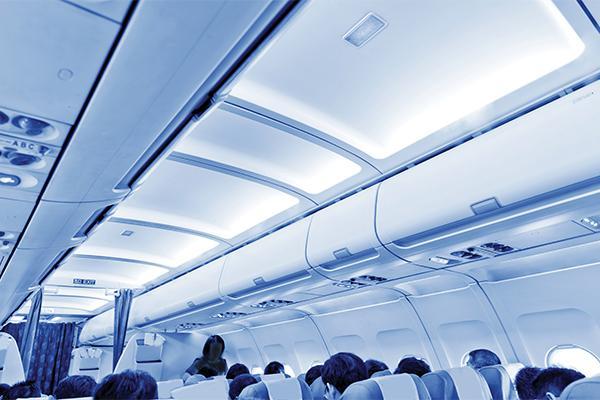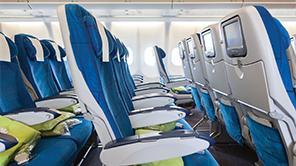Safeguarding Interior Egress Points with Dual Point Latching Systems

Dual point latching systems offer a standardized solution to a wide variety of design challenges within the aircraft cabin, allowing design engineers the freedom to design around a dependable system, regardless of changes in actuation or mounting style modifications.
With lightweighting at the forefront of new aircraft design, engineers designing storage panels and doors into aircraft cabins are tasked with incorporating mechanisms that allow maintenance personnel or crew to easily access storage or supplies located in maintenance panels, lavatory, galley or ceiling, without adding unnecessary weight.
In addition to these new design considerations, engineers must also ensure that designs selected meet aircraft safety requirements. When designing new interior applications, selecting a versatile, core latching mechanism can greatly improve access to doors and panels within the aircraft, while ensuring that they do not fall out of position and inhibit passenger egress points in the event of an emergency.
Implementing a dual point latching solution helps prevent potential problems that could occur during flight, such as false latching conditions or inadvertent door opening which can occur due to vibration or turbulence.
Dual Point Latching Security
Dual point systems offer a standardized solution to a wide variety of design challenges within the aircraft cabin, allowing design engineers the freedom to design around a dependable system, regardless of changes in actuation or mounting style. Using a standardized mechanism across applications ensures that doors remain closed and latched securely in place during taxi, takeoff and landing.
In general, coupler systems feature a two-point, dependent pawl latching mechanism which retracts both pawls simultaneously, preventing the risk of false latching. This dependent motion allows the mechanism to be actuated anywhere along the length of the assembly, making it compatible with a wide variety of actuation options, including pushbutton, side-pull, lift paddle, electronic and even hidden tool secured, providing flexibility in styling.
Southco’s Dual Point Coupler System is a robust solution constructed of lightweight engineered thermoplastics, consisting of two pawls and a coupler mechanism. It features a cartridge-style installation that allows it to be easily mounted between panels, enabling a clean, flush exterior. The Dual Point Coupler System features 17mm of travel, which facilitate assistance with door assembly and gap conditions that exist between the door and surrounding instrument panel. It also allows flexibility of latch points regardless of panel shape or size.
Southco’s Dual Point Couplers feature a two-point, dependent pawl latching mechanism which retracts both pawls simultaneously, and can be actuated anywhere along the length of a door or panel for optimum design flexibility.
The result is a clean design, with consistent actuation and opening/closing efforts. Because it will not latch unless both pawls are fully engaged, this two-pawl solution avoids potential problems that could occur during flight, such as false latching conditions or inadvertent door opening which can occur due to vibration or turbulence.
Dual Point Coupler System Features & Benefits
Southco’s Dual Point Coupler System features a two-point, dependent pawl latching mechanism which retracts both pawls simultaneously, preventing the risk of false latching
- Tested and validated solution with flexible actuation styles to allow for platformable design, reducing design time and certification testing
- Mechanism can be actuated anywhere along the length of a door or panel
- Compatible with a wide variety of actuation options
- Can be easily mounted between panels, allowing a clean, flush exterior
- Addresses Aerospace industry standards for redundant latch points
Redundant Latching Requirements
When designing for interior aircraft applications, engineers must balance the need for functionality as well as Federal Aviation Association (FAA) safety requirements. To ensure compliance with Aerospace industry directives, aircraft OEMs must choose parts that perform against even the most stringent requirements, such as the need for redundant latching.
A key design factor that must be accommodated in aircraft interior design is preventing the obstruction of passenger egress. Should an emergency occur and passengers need to quickly exit the aircraft, exit doors and egress points must be kept clear to facilitate evacuation. Incorporating a redundant latching system into doors and panels ensures that they remain securely closed and out of the path of egress even if part of the latch fails due to damage caused by smoke, fire or impact.
If a latching mechanism should fail in the event of an emergency, airlines could potentially face penalties for noncompliance. Choosing a dual point latching mechanism ensures that if one access point should fail, the door or panel will still remain closed, allowing passengers and crew to exit an aisle. Southco’s Dual Point Coupler System for instance, can address Aerospace industry standards for redundant latch points and redundant actuation when combined with the appropriate actuator.
Conclusion
As lightweighting continues to be a predominant trend in the Aerospace industry, and manufacturers make design adjustments to aircraft interiors, design engineers must anticipate new challenges presented by lightweight materials and adjust their designs accordingly. When designing around modified cabin interiors, design engineers are tasked with implementing solutions that not only solve the functional needs of an application but also meet Aerospace industry safety requirements.
By integrating lightweight dual point latching mechanisms into aircraft interior applications such as access paneling, lavatories, storage equipment and galleys, aircraft OEMs can ultimately improve usability, safety and reliability for aircraft maintenance and crew.



